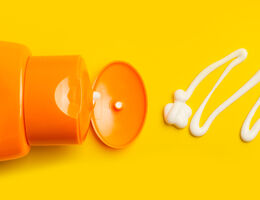
May 9, 2024—Think you know what the SPF number on your sunscreen means? You may be missing some details about how to protect yourself from skin cancer, the most common cancer in the United States. Get answers to some frequently asked questions about SPF from the American Academy of Dermatology (AAD), the U.S. Food and Drug Administration (FDA) and other experts.
Q. What does SPF mean?
The abbreviation SPF on a sunscreen label stands for sun protection factor. The SPF number indicates the level of protection a sunscreen provides against ultraviolet UVB rays, which are the main cause of sunburns.
The SPF number indicates the amount of solar energy it would take for you to get a sunburn. For example, an SPF of 30 means that it would take 30 times as much solar energy exposure for you to burn while using the sunscreen compared to not using any sunscreen.
Q. Does your SPF affect how long you can safely be out in the sun?
Some people think SPF is a measure of time—meaning that if it usually takes an hour of sun exposure to cause a sunburn, sunscreen with SPF 30 lets you go 30 hours out there without burning. That isn't how it works.
According to FDA, SPF measures solar energy, not time. And how much solar energy you're exposed to is affected by a range of factors, including your location, the weather and the time of day. For example, you might be exposed to the same amount of solar energy in an hour in the early morning and in only 15 minutes of afternoon sun.
Furthermore, it's important to remember that, regardless of SPF, sunscreen needs to be reapplied at least every two hours (or sooner if you're swimming or sweating). And to get the promised protection, you may need more than you think. Most adults need at least an ounce of sunscreen to cover their body. (That's enough to fill a shot glass.)
Q. Are higher SPFs better?
Yes, to a point. The higher the SPF, the higher the protection. Correctly applied, sunscreen with SPF 15 blocks 93% of the sun's UVB rays, while SPF 30 sunscreen blocks 97% and SPF 50 blocks 98%. To help prevent skin cancer, the AAD recommends using an SPF of 30 or above—and lots of it.
But no sunscreen can block 100% of the sun's damaging rays. And the AAD warns that higher SPFs don't mean you can spend more time in the sun without reapplying. Worse, using sunscreen with a high SPF may create a false sense of safety and end up offering less protection than a lower SPF that you apply and reapply correctly.
Q. What else should I look for when shopping for sunscreen?
Always check for the phrase broad-spectrum on the bottle. This means it protects you from both UVB and UVA rays. Choose a sunscreen that is water-resistant for better staying power. Label claims that call a sunscreen "waterproof" are just marketing. There is no such thing as waterproof sunscreen.
Beyond SPF
Sunscreen is an important step in your sun-safety routine. But no matter what SPF you choose, it can't offer complete protection. To protect your skin, check out these seven sun-safety steps.
Sources
- American Academy of Dermatology. "Confused About Sunscreen? New American Academy of Dermatology Survey Shows Americans Need a Refresher on Sunscreen Application and SPF." https://www.aad.org/news/aad-survey-shows-americans-need-sunscreen-education.
- American Academy of Dermatology. "How to Decode Sunscreen Labels." https://www.aad.org/public/everyday-care/sun-protection/shade-clothing-sunscreen/understand-sunscreen-labels.
- American Academy of Dermatology. "Sunscreen FAQs." https://www.aad.org/media/stats-sunscreen.
- Skin Cancer Foundation. "Ask the Expert: Does a High SPF Protect My Skin Better?" https://www.skincancer.org/blog/ask-the-expert-does-a-high-spf-protect-my-skin-better/.
- U.S. Food and Drug Administration. "Sun Protection Factor (SPF)." https://www.fda.gov/about-fda/center-drug-evaluation-and-research-cder/sun-protection-factor-spf.